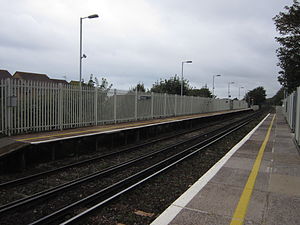 Westward view from the eastbound platform at Aldrington | |||||
| General information | |||||
| Location | Hove, Brighton & Hove England | ||||
| Grid reference | TQ281056 | ||||
| Managed by | Southern | ||||
| Platforms | 2 | ||||
| Other information | |||||
| Station code | AGT | ||||
| Classification | DfT category F1 | ||||
| Key dates | |||||
| 3 September 1905 | opened as Dyke Jn Halt | ||||
| 17 June 1932 | resited and renamed Aldrington Halt | ||||
| Passengers | |||||
| 2019/20 | |||||
| 2020/21 | |||||
| 2021/22 | |||||
| 2022/23 | |||||
| 2023/24 | |||||
| |||||

Aldrington railway station, sometimes known by its former names of Aldrington Halt and Dyke Junction, is a railway station that serves the area of Aldrington in Brighton and Hove, in East Sussex, England. The station is 1 mile 74 chains (3.1 km) from Brighton on the West Coastway Line.
Dyke Junction Halt was opened in 1905[1] by the London, Brighton and South Coast Railway with short wooden platforms. In 1932 new longer platforms were constructed on an adjacent site nearer Hove to the previous platforms. They were renamed Aldrington Halt and later rebuilt in concrete by the Southern Railway. It is situated just east of the former junction with the branch line to Devil's Dyke, which opened in 1887 and closed in 1939; the layout and curvature of certain roads and buildings immediately north-west of the station indicates where the branch ran.
The station was staffed during peak hours until approximately 1990, after which the hut which served as a ticket office was demolished. By 2009 the old concrete shelters had been replaced with reinforced plastic shelters which are now the only features on the platforms. Ramps lead down to street level.
There are ticket-issuing machines at the entrances to each platform. Pre-purchased tickets can also be collected on these machines. There is no footbridge connecting the platforms with each other. However, there is a tunnel under the railway lines at the western end of the platforms which was originally built to allow the local farmer to move his cattle between fields which became separated with the arrival of the railway.
- ^ Turner, JT Howard (1979). The London, Brighton & South Coast Railway 3: Completion and Maturity (First ed.). London: BT Batsford Ltd. p. 162. ISBN 0-7134-1389-1.